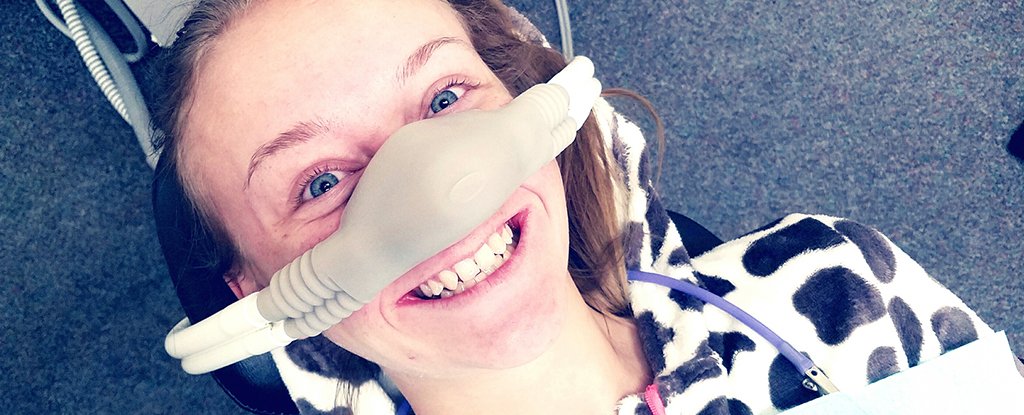
Psychoactive drugs, historically taken at parties, are increasingly looking to be suitable tools for treating mental illness.
In phase III clinical trials, MDMA has emerged as a highly effective treatment for post traumatic stress disorder, and in recent studies, oral ketamine has been found to significantly lower suicidal ideation.
Nitrous oxide, or laughing gas, is now joining the ranks. A new trial on 24 participants in the United States has found a low dose of this gas can relieve symptoms of depression otherwise resistant to current drugs.
Even better, the benefits appear to last for several weeks and come with very few side effects.
"The reduction in side effects was unexpected and quite drastic, but even more excitingly, the effects after a single administration lasted for a whole two weeks," says trauma anesthesiologist Peter Nagele from the University of Chicago.
"This has never been shown before. It's a very cool finding."
When nitrous oxide was first discovered in the late 1700s, chemists in England threw laughing gas parties for an elite crowd. The festivities were sold as 'experiments' at the time, to figure out how the drug actually worked.
Party goers reported feeling euphoric and pain free, which is why nitrous oxide was soon adapted for use in dentistry and surgery. Hundreds of years later, most of us know the drug as an anesthetic or sedative.
In the past few years, however, scientists have been re-examining this drug and its use in clinical settings.
In 2015, a proof-of-principle study found breathing in a gas made up of 50 percent nitrous oxide for just an hour has rapid antidepressant effects. Depression dropped significantly in the day following treatment for most volunteers; among those whose moods were checked a week later, though, the results didn't seem to last. While there were no serious adverse effects, many participants reported feeling nauseous, light-headed, or paranoid.
But new follow-up research suggests this doesn't have to be the case. In a recent randomized phase II clinical trial, 24 volunteers with treatment-resistant major depression were randomly assigned three different treatments staggered across three months, with a month between each treatment.
The first treatment involved an hour-long high dose of nitrous oxide (at 50 percent), the second involved an hour-long low dose of the drug (at 25 percent), and the last involved a placebo.
Not everyone in the study responded the same to each treatment, and there was a strong placebo effect for some. That said, the majority of people in the trial showed a high rate of response and symptom improvement over the course of three months.
These benefits are greater than what is observed with other traditional antidepressants, researchers say, and they appear to last longer than we previously thought.
Two weeks after each treatment, researchers found those who had been given the laughing gas at either dosage showed lasting benefits compared to when they received a placebo.
The higher dose of laughing gas, however, was associated with four times more side effects on average. A lower dose mostly put patients to sleep.
"This investigation was motivated by observations from research on ketamine and depression," explains Nagele.
"Like nitrous oxide, ketamine is an anesthetic, and there has been promising work using ketamine at a sub-anesthetic dose for treating depression. We wondered if our past concentration of 50 percent had been too high. Maybe by lowering the dose, we could find the 'Goldilocks spot' that would maximize clinical benefit and minimize negative side effects."
The sample size of the current study is small, and because researchers only followed up with patients after two weeks, it's unclear whether the effects of the first nitrous oxide treatment carried over into the next bout of laughing gas.
This could bolster the drug's lasting effects, which means multiple doses of laughing gas might be beneficial as a longer term treatment.
A single hour of nitrous oxide inhalation, on the other hand, might not last for as long.
Far more research is needed before we can harness the benefits of this drug for clinical depression in a safe and effective way, but given how many millions of people do not respond to current antidepressants, alternative treatments are desperately needed.
"These have just been pilot studies," says Nagele. "But we need acceptance by the larger medical community for this to become a treatment that's actually available to patients in the real world. Most psychiatrists are not familiar with nitrous oxide or how to administer it, so we'll have to show the community how to deliver this treatment safely and effectively."
The study was published in Science Translational Medicine.
Article From & Read More ( Small Doses of 'Laughing Gas' Show Promise as Depression Treatment - ScienceAlert )https://ift.tt/3gmllkl
Health
Bagikan Berita Ini














0 Response to "Small Doses of 'Laughing Gas' Show Promise as Depression Treatment - ScienceAlert"
Post a Comment